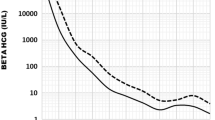Abstract
The epidemiology of gestational trophoblastic disease (GTD) is not well defined. The rarity of the disease and challenges in data collection limit interpretation of incidence data. Incidence of GTD appears to be influenced by geographic region, with the highest rates occurring in Southeast Asia and Japan. Risk factors for molar pregnancy include extremes of maternal age, reproductive history, and dietary deficiencies. Risk factors for choriocarcinoma include age, ethnicity, history of complete molar pregnancy, and ABO blood group status. With improvements in socioeconomic conditions and diet as well as diagnosis and management of GTD, the incidence of trophoblastic disease is declining worldwide. Future studies should focus on mechanisms by which risk factors influence development and progression of GTD.
Similar content being viewed by others
References
Lurain J. Gestational trophoblastic disease I: epidemiology, pathology, clinical presentation and diagnosis of gestational trophoblastic disease, and management of hydatidiform mole. Am J Obstet Gynecol. 2010;203:531–9.
Lurain J. Gestational trophoblastic diseases. In: Mayer I, editor. Textbook of uncommon cancer. John Wiley & Sons, Ltd; 2006. p. 532–42
Berkowitz RS, Goldstein DP. Current management of gestational trophoblastic disease. Gynecol Oncol. 2009;112:654–62.
Bracken MB. Incidence and etiology of hydatidiform mole: an epidemiologic review. BJOG. 1987;94:1123–35.
Atrash HK, Hogue CJR, Grimes DA. Epidemiology of hydatidiform mole during early gestation. Am J Obstet Gynecol. 1986;154:906–9.
Takeuchi S. Incidence of gestational trophoblastic disease by regional registration in Japan. Hum Reprod. 1987;2:729–34.
Bagshawe KD, Dent J, Webb J. Hydatidiform mole in England and Wales 1973-1983. Lancet. 1986;2:673–7.
Smith HO. Gestational trophoblastic disease: epidemiology and trends. Clin Obstet Gynecol. 2003;46:541–56.
Martin BH, Kim JM. Changes in gestational trophoblastic tumors over four decades: a Korean experience. J Reprod Med. 1998;43:60–8.
Berkowitz RS, Cramer DW, Bernstein MR, et al. Risk factors for complete molar pregnancy from a case-control study. Amer J Obstet Gynecol. 1985;152:1016–20.
Parazzini F, LaVecchia C, Mangili G, et al. Dietary factors and risk of trophoblastic disease. Amer J Obstet Gynecol. 1988;158:93–9.
Lage JM, Mark SD, Roberts DJ, et al. A flow cytometric study of 137 fresh hydrophic placentas: correlation between types of hydatidiform moles and nuclear DNA ploidy. Obstet Gynecol. 1992;79:403–10.
Parazzini F, Mangili G, LaVecchia C, et al. Risk factors for gestational trophoblastic disease: a separate analysis of complete and partial hydatidiform mole. Obstet Gynecol. 1991;78:1039–45.
Parazzini F, LaVecchia C, Pampallona S. Parental age and risk of complete and partial hydatidiform mole. BJOG. 1986;93:582–5.
Sebire NJ, Foskett M, Fisher RA, et al. Risk of partial and complete molar pregnancy in relation to maternal age. BJOG. 2002;109:99–102.
Sand PK, Lurain JR, Brewer JL. Repeat gestational trophoblastic disease. Obstet Gynecol. 1984;63:140–4.
Berkowitz RS, Im SS, Bernstein MR, Goldstein DP. Gestational trophoblastic disease: subsequent pregnancy outcome, including repeat molar pregnancy. J Reprod Med. 1998;43:81–6.
Sebire NJ, Fisher RA, Foskett M, et al. Risk of recurrent hydatidiform mole and subsequent pregnancy outcome following complete or partial hydatidiform mole. BJOG. 2003;110:22–6.
Acaia B, Parazzini F, LaVecchia C, et al. Increased frequency of complete hydatidiform mole in women with repeated abortion. Gynecol Oncol. 1988;31:310–4.
Wang CM, Dixon PH, Decordova S, Hodges MD, Sebire NJ, Ozalp S, et al. Indentification of 13 novel NLRP7 mutations in 2 families with recurrent hydatidiform mole; missense mutations cluster in the leucine-rich region. J Med Genet. 2009;46:569–75.
Palmer JR. Advances in the epidemiology of gestational trophoblastic disease. J Reprod Med. 1994;39:155–62.
Palmer JR, Driscoll SG, Rosenberg L, et al. Oral contraceptive use and risk of gestational trophoblastic tumors. J Natl Cancer Inst. 1999;91:635–40.
Berkowitz RS, Bernstein MR, Harlow BL, et al. Case-control study of risk factors for partial molar pregnancy. Gynecol Oncol. 1995;173:788–94.
Smith HO, Qualls CR, Prarie BA, et al. Trends in gestational choriocarcinoma: a 27-year perspective. Obstet Gynecol. 2003;102:978–87.
Brinton LA, Bracken MB, Connelly RR. Choriocarcinoma incidence in the United States. Am J Epidemiol. 1986;123:1094–100.
Baltazar JC. Epidemiological features of choriocarcinoma. WHO Bulletin. 1976;54:523–32.
Buckley JD, Henderson BE, Morrow CP, et al. Case-control study of gestational choriocarcinoma. Cancer Res. 1988;48:1004–10.
Costa HL, Doyle P. Influence of oral contraceptives in the development of post-molar trophoblastic neoplasia - a systematic review. Gynecol Oncol. 2006;100:579–85.
Compliance with Ethics Guidelines
ᅟ
Conflict of Interest
Anna E. Strohl and John R. Lurain declare that they have no conflict of interest
Human and Animal Rights and Informed Consent
This article does not contain any studies with human or animal subjects performed by any of the authors.
Author information
Authors and Affiliations
Corresponding author
Rights and permissions
About this article
Cite this article
Strohl, A.E., Lurain, J.R. Clinical Epidemiology of Gestational Trophoblastic Disease. Curr Obstet Gynecol Rep 3, 40–43 (2014). https://doi.org/10.1007/s13669-013-0070-7
Published:
Issue Date:
DOI: https://doi.org/10.1007/s13669-013-0070-7




